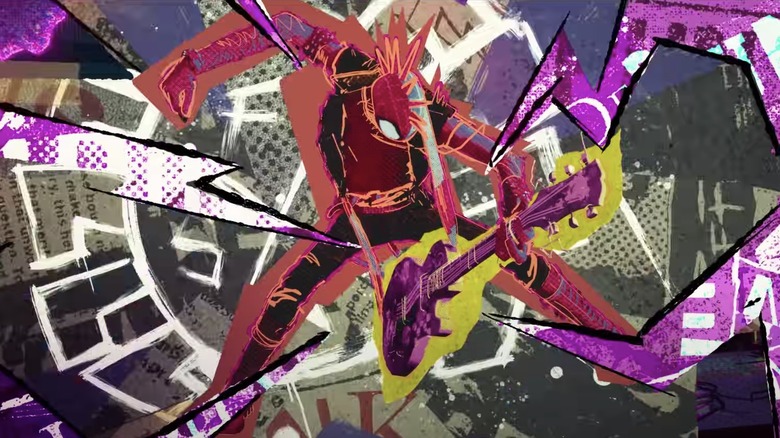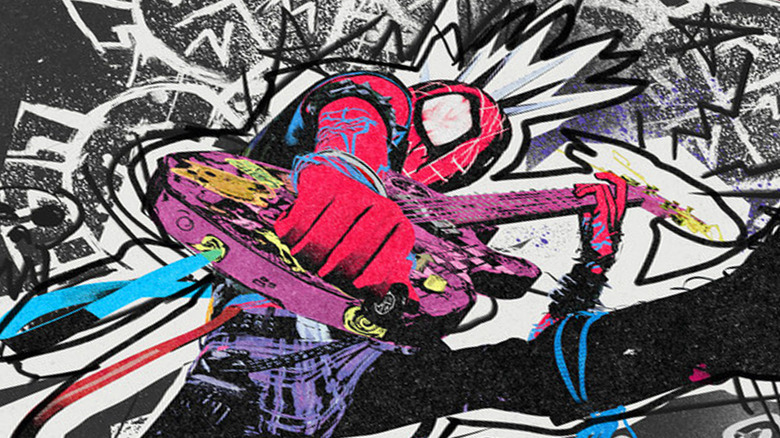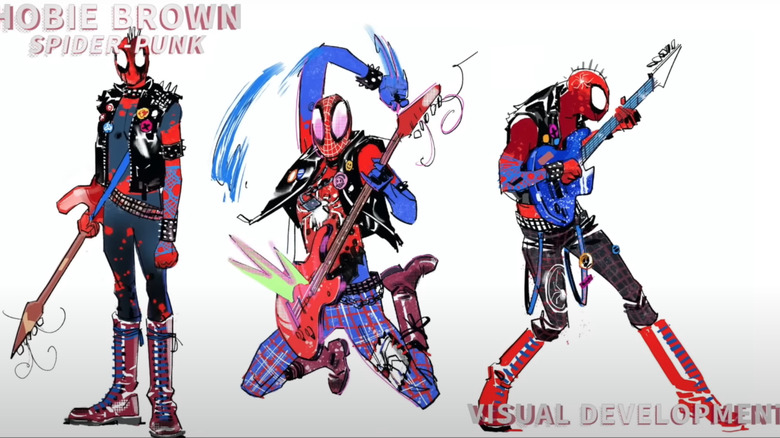Spider-Man: Across The Spider-Verse's Spider-Punk Took Three Years To Animate
The best thing about "Spider-Man: Across the Spider-Verse" is the way it handles the multiverse concept itself. The film's surprisingly culturally-aware and thoughtful storyline, the performances, and that excellent cliffhanger ending all combine to make it one of the best Spider-Man movies — and perhaps just movies, in general — ever made. But for me, the multiverse as a concept is so compelling because of the parallels with our own cultural moment. Right now, you can easily immerse yourself in any subculture you like via the internet. All of history is accessible. And "Across the Spider-Verse" manages to convey that sense of grand concatenation entirely through its visuals — which, it's not an exaggeration to say, are genuinely astonishing.
The movie combines a multitude of artistic styles from throughout the entirety of human history, from the Italian Renaissance-inspired Vulture at the film's start, to the watercolor mood ring backgrounds of Gwen Stacy (Hailee Steinfeld)'s world. "Across the Spider-Verse" is itself a multiverse of artistic styles. But there's one character who's fast-becoming a fan-favorite not just for his anti-establishment sense of cool, but because the animators truly outdid themselves when crafting the anarchic hero's aesthetic and bringing some authentic punk sensibilities into their multiverse: Hobie Brown, aka Spider-Punk.
Voiced by the Camden-born Daniel Kaluuya (who puts on a cockney accent so thick, even I as a Brit, former Londoner, and seasoned "Eastenders"-watcher couldn't understand a word he was saying at first), Spider-Punk is easily the coolest new addition to the "Spider-Verse" movies. Hobie Brown's DIY style brings the punk aesthetic to vivid life, making the character a stand out in a relentlessly awe-inspiring movie. But bringing such a feat to fruition was about as hard a challenge as the "Across the Spider-Verse" animators ever faced.
'Let's try all these crazy experiments'
Debuting in "Across the Spider-Verse" as a friend and possible love interest for Gwen Stacy, Hobie Brown made his first comic book appearance back in "Amazing Spider-Man" (Vol. 3) #10 in November 2014 before getting his first solo story in 2015's "Spider-Verse" #2. He's since been a part of various Spidey stories, but the character's arrival in Sony's latest Spider-Man effort will no doubt increase his popularity ten-fold — especially since he looks so damn cool.
Basically a punk show flyer brought to life, Spider-Punk's uniqueness in "Across the Spider-Verse" is represented by his constantly-shifting appearance. Whereas Gwen, Miles, and even the newly introduced Indian Spider-Man all have a consistent look, Spider-Punk's form is continually transforming, not only conveying his restless anti-establishment energy but allowing the animators to combine decades of punk culture into a single manifestation, challenging their own skills in the process.
Speaking to Discussing Film, directors Justin K. Thompson, Joaquim Dos Santos, and Kemp Powers explained their approach to animating Hobie Brown, with Thompson explaining that they wanted the character's animation style to represent punk rock's "rejection of norms, authority, and traditional ideas." That meant trying a lot of "crazy experiments" that emulated the style of "punk rock zines and punk rock posters," which Thompson noted are "hand cut, pasted, drawn, glued together, and then xeroxed as well."
But the director's vision for Spider-Punk went beyond some hollow pastiche of punk style, with the trio developing new tools to give Hobie the chaotic energy they were looking for.
Breaking the rules
Justin K. Thompson was determined to have the film's version of Spider-Punk not just look like an old punk flyer but feel like one come to life. The co-director explained:
"We developed all these crazy technical tools. They start with this traditional animation pass, and then the tools that we developed can adapt all the different parts of him to all these different custom looks we created that are based on classic punk rock posters."
Not only that, but each part of Hobie's body was assigned different "emotional beats" and "sudden visual changes," which, according to Thompson, ultimately meant developing an animation process that took "two or three years" to get right.
The animators also repurposed the own frame-rate trick from 2018's "Into the Spider-Verse." In that movie, the team animated Jake Johnson's Peter B. Parker web-swinging his way out of danger at 24 frames-per-second, while Miles Morales was animated at 12-frames-per second to convey his relative inexperience. In "Across the Spider-Verse," the animators applied this same technique to Spider-Punk himself, with Joaquim Dos Santos explaining:
"Spider-Punk's jacket is animated at a different frame rate oftentimes from the rest of his body. So sometimes when the perspective shifts hard enough, his jacket will just be held and then it will quickly pop to the next perspective. But his body and his head are moving at a different frame rate, too. That fact alone is breaking a lot of rules for an animated film."
In that sense, the "Across the Spider-Verse" version of Spider-Punk is a living embodiment of the character's ethos and the film's central theme of forging your own path and not adhering to established rules. Andy Samberg's Scarlet Spider might be one of the coolest new characters, but Spider-Punk clearly has him beat.


